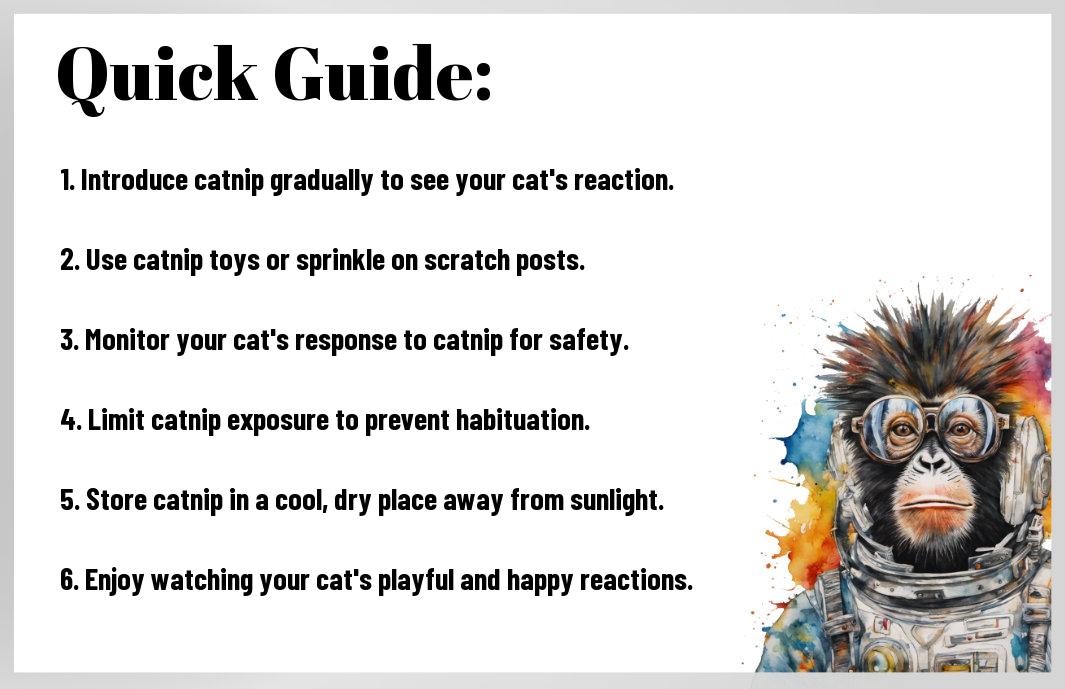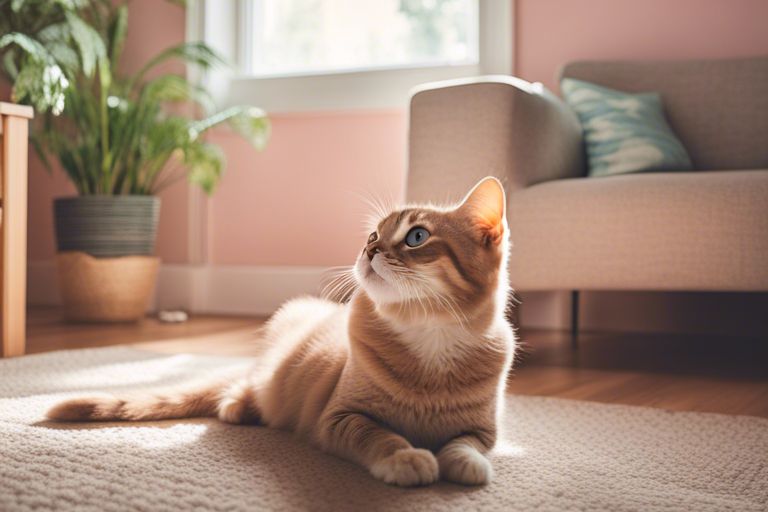This comprehensive guide will help you understand all about catnip and how to use it effectively for your beloved feline friend. Discover the exciting effects catnip can have on your cat, how to use it safely, and potential side effects to watch out for. From choosing the right catnip product to understanding how it interacts with your furry companion, this guide will ensure your kitty has a purr-fect experience with catnip.
Key Takeaways:
- Understand your cat’s sensitivity: Not all cats react to catnip, and sensitivity can vary among those that do.
- Use catnip in moderation: Excessive use of catnip may reduce its effectiveness on your cat.
- Try different forms of catnip: Experiment with fresh, dried, or catnip-infused toys to see what your cat prefers.
- Observe your cat’s behavior: Pay attention to how your cat reacts to catnip to ensure they are enjoying it responsibly.
- Store catnip properly: Keep catnip products in airtight containers away from sunlight to preserve their potency.


Understanding Catnip
What is Catnip?
One of the most fascinating things about catnip is the plant’s unique effect on your feline friend. Catnip, scientifically known as Nepeta cataria, is a herb belonging to the mint family. The compound that drives cats crazy is nepetalactone, which is found in the leaves and stems of the plant.
History of Catnip
For centuries, catnip has been known for its peculiar effect on cats. The use of catnip can be traced back to ancient times, where people observed the reactions of felines to the herb. It was also used in traditional medicine for various purposes.
Another interesting fact about the history of catnip is that it was brought to North America by early European settlers who recognized its value in attracting and stimulating cats. Today, catnip is widely available and used for recreational purposes for cats.
How Does Catnip Affect Cats?
Some cats may not react to catnip at all, as sensitivity to nepetalactone is an inherited trait. When understanding how catnip affects cats, it’s vital to know that the reactions can vary from cat to cat. Common behaviors include sniffing, licking, chewing, head shaking, and rolling around in euphoria after exposure to catnip.
Some cats may become more playful and energetic, while others may enter a state of calm relaxation. The effects typically last for about 10-15 minutes, after which your cat may lose interest in the catnip until a few hours have passed.
Types of Catnip
It is imperative to know about the different types of catnip available to understand what might work best for your feline companion. Below is a breakdown of some common types of catnip:
| Nepeta Cataria | Nepeta Faassenii |
|---|---|
| Also known as: True catnip, catmint | Also known as: Faassen’s catnip, garden catmint |
| Effect: Calming and soothing | Effect: A hybrid variety that is less potent |
| Benefits: Stimulates play and exercise | Benefits: Safe for most cats and encourages play |
| Usage: Great for training or calming anxious cats | Usage: Ideal for daily use and less intense reactions |
Nepeta Cataria – The Most Common Type
Types of catnip include Nepeta Cataria, also known as True catnip or catmint. It is the most common type of catnip, known for its calming and soothing effects on cats. Nepeta Cataria is great for stimulating play and exercise in your feline friend. The Catnip 101: Everything You Need to Know and How to Use It … guide is a useful resource to learn more.
Nepeta Faassenii – A Hybrid Variety
If you are looking for a less potent type of catnip, Nepeta Faassenii, also known as Faassen’s catnip or garden catmint, is a hybrid variety to consider. This type of catnip is safe for most cats and encourages play without eliciting intense reactions. Most cats respond well to Nepeta Faassenii, making it ideal for daily use.
Most felines enjoy the effects of Nepeta Faassenii, as it provides a subtle yet pleasant experience. This hybrid variety offers a gentle stimulation that is perfect for regular play sessions with your pet.
Nepeta Camphorata – A Rare Type
Any discussion about types of catnip would be incomplete without mentioning Nepeta Camphorata. This rare type of catnip has unique properties that may appeal to some cats. Recognizing the benefits and effects of Nepeta Camphorata can help you determine if it is suitable for your furry friend.
Faassenii
Nepeta Camphorata offers a different experience compared to more common varieties of catnip. Some cats may find the effects of this rare type intriguing and enjoyable. Understanding the characteristics of Nepeta Camphorata can guide you in deciding whether to introduce it to your cat.
Other Types of Catnip
When exploring various types of catnip, you may come across other lesser-known varieties with distinct qualities. Recognizing the differences between these types can help you choose the right one for your cat. Here are some other types of catnip to consider:
| Nepeta Mussinii | Nepeta Parnassica |
|---|---|
| Also known as: Mussin’s catmint | Also known as: Parnassus catmint |
| Effect: Mild and gentle | Effect: Invigorating and stimulating |
| Benefits: Suitable for sensitive cats | Benefits: Encourages active play |
| Usage: Ideal for relaxed playtime | Usage: Perfect for energetic cats |
Assuming you are considering introducing a new type of catnip to your pet, it is crucial to understand the unique characteristics of each variety. Recognizing the effects and benefits of different types of catnip can help you provide the best experience for your cat. Variety in catnip options allows you to tailor your feline friend’s playtime to their preferences.

Factors to Consider When Choosing Catnip
Unlike other products for your feline friend, catnip comes in various forms and qualities. Here are some factors you should consider when choosing catnip:
Quality of Catnip
Even though catnip is a simple herb, the quality can vary greatly. When choosing catnip for your cat, opt for organic options to ensure that it is free from pesticides and other harmful chemicals. High-quality catnip will provide a more potent and enjoyable experience for your furry companion. Though it may be a bit more expensive, the benefits are well worth it.
Potency of Catnip
Now, when it comes to the potency of catnip, not all products are created equal. Some catnip may be fresher and more potent than others. A higher potency catnip will elicit a stronger reaction from your cat, providing more entertainment and joy. Be sure to choose catnip that is fresh and has a strong aroma to ensure maximum enjoyment for your pet.
Choosing the right catnip for your cat can make a big difference in their overall experience and enjoyment. Be sure to consider the freshness, quality, and potency of the catnip before making a selection.
Freshness of Catnip
Quality catnip should be fresh and aromatic. When choosing catnip for your cat, be sure to choose products that are vibrant in color and have a strong scent. Fresh catnip will be more enticing to your cat and provide a more stimulating experience.
When catnip is fresh, it contains more of the important oils that cats go wild for. This means that your cat will have a more intense reaction to the catnip, leading to more fun and excitement during playtime.
Organic vs. Non-Organic Catnip
Catnip can be found in both organic and non-organic forms. This is an important consideration when choosing catnip for your pet. Organic catnip is grown without the use of pesticides or chemicals, making it a safer option for your cat. Additionally, organic catnip is often of higher quality and potency, providing a better experience for your furry friend.
Tips for Using Catnip Effectively
Now, when it comes to using catnip with your feline friend, there are a few tips that can help you make the most of this herb’s magical effects. Here are some suggestions to ensure a paw-sitively delightful experience for your cat:
Start with Small Amounts
With catnip, less is often more. Start by offering a small amount of the herb to your cat to gauge their reaction. Some cats may be more sensitive to catnip than others, so it’s important to observe how your cat responds before offering more. You can gradually increase the amount as needed to see the desired effects. Knowing your cat’s tolerance level will help prevent overstimulation.
Choose the Right Form of Catnip
Even though catnip is widely available in various forms such as dried leaves, sprays, and cat toys, not all cats may respond to each form in the same way. Some cats may prefer the dried leaves, while others may enjoy rubbing against a catnip-infused toy. It’s necessary to experiment with different forms to see which one your cat enjoys the most. Formulating the right catnip experience will ensure your cat has a meow-nificent time.
Use Catnip in Rotation with Other Toys
Catnip can be a fantastic addition to your cat’s playtime routine, but using it too frequently may lessen its effects over time. Incorporating catnip toys into play sessions on a rotational basis can help maintain your cat’s interest and prevent habituation. Introducing new catnip toys or reactivating old ones can keep the experience fresh and exciting for your feline friend.
Observe Your Cat’s Preferences
While catnip is known to induce playful behavior in most cats, it’s necessary to observe your cat’s individual preferences. Some cats may become more energetic, while others may become more mellow or even exhibit no reaction at all. Plus, keep in mind that the effects of catnip typically last for about 10-15 minutes, after which your cat may lose interest. By paying attention to your cat’s reactions and adjusting their catnip playtime accordingly, you can ensure a purr-fectly enjoyable experience for your furry companion.
Step-by-Step Guide to Using Catnip
For a successful catnip experience with your feline friend, follow this step-by-step guide that will ensure your cat has a pawsitively delightful time!
Preparing Your Cat for Catnip
| If it’s your cat’s first time trying catnip, start with a small amount to gauge their reaction. |
Provide a safe and comfortable space for your cat to enjoy the catnip, away from any distractions. |
Introducing Catnip to Your Cat
| Clearly introduce the catnip by gently rubbing it on your cat’s favorite toys or scratching posts. |
Observe your cat’s reaction to the catnip and adjust the amount used based on their response. |
This will help your cat associate the smell of catnip with fun and playtime. Do not forget, not all cats are affected by catnip, as sensitivity to it is hereditary.
Encouraging Play with Catnip
Encouraging your cat to play with catnip can help provide mental and physical stimulation. You can sprinkle some catnip on the floor or a scratching post for your cat to discover and enjoy. Additionally, interactive toys filled with catnip can keep your cat engaged and entertained for hours.
Encouraging your cat to engage in play with catnip can also help build a stronger bond between you and your feline companion. It’s a great way to enhance their environment and provide enrichment in their daily routine.
Creating a Catnip-Friendly Environment
| Plus, you can create a catnip garden in your home by growing catnip plants indoors or outdoors. |
Place catnip-infused toys strategically around your home to keep your cat stimulated and happy. |
Creating a catnip-friendly environment enriched with various catnip toys and accessories can turn your home into a playground for your beloved cat. Remember to always monitor your cat’s playtime with catnip to ensure they are safe and not overindulging in the herb.

Pros and Cons of Using Catnip
Many cat owners wonder about the benefits and drawbacks of using catnip with their feline friends. It’s important to weigh both sides before introducing your cat to this popular herb. Below is a breakdown of the pros and cons of using catnip:
| Pros | Cons |
| Induces a natural high | Possible overstimulation |
| Encourages play and exercise | Sensitivity varies among cats |
| Can help with stress relief | Effects wear off over time |
Benefits of Using Catnip
You may find that using catnip is a fun way to bond with your cat. It can enhance playtime and encourage your cat to stay active. Additionally, the calming effects of catnip can be beneficial for anxious cats.
Potential Drawbacks of Using Catnip
Clearly, some cats may react negatively to catnip or may not be affected at all. It is important to observe your cat’s behavior and moderate their exposure to catnip accordingly.
Consistent use of catnip may lead to your cat building up a tolerance to its effects. In such cases, you may notice a reduced response over time.
Addressing Common Concerns
Even if your cat reacts positively to catnip, it’s vital to use it in moderation to prevent potential overstimulation. Always supervise your cat when introducing new toys or products containing catnip.
Benefits Catnip is a safe and natural herb that can provide mental stimulation and encourage healthy behavior in your feline friend. By understanding the pros and cons, you can make informed decisions about using catnip with your cat.
Conclusion
The next time you want to treat your feline friend to a special gift, consider getting some catnip and watching them indulge in its effects. Remember to use it in moderation, as too much of a good thing can sometimes have adverse effects. By following the tips and guidelines outlined in this guide, you can ensure that your cat has a safe and enjoyable experience with catnip.
The bond between you and your cat can be strengthened through simple pleasures like sharing catnip. Watching your cat roll around in joy or become more playful can bring a smile to your face and create lasting memories. With the right knowledge and care, catnip can be a wonderful addition to your cat’s life, providing enrichment and fun for both of you.
FAQ
Q: What is catnip?
A: Catnip is a herb from the mint family, scientifically known as Nepeta cataria, which has a unique effect on cats, making them behave excitedly or mellow when exposed to it.
Q: Is catnip safe for cats?
A: Yes, catnip is non-toxic and safe for cats to eat or interact with. However, it is recommended to use it in moderation to avoid overstimulation.
Q: How does catnip affect cats?
A: Catnip contains a compound called nepetalactone that triggers a response in a cat’s brain, leading to behaviors such as rolling, rubbing, purring, or increased energy.
Q: Can all cats enjoy catnip?
A: Not all cats are affected by catnip. It is estimated that about 50-70% of cats have a gene that makes them respond to catnip, while others may not show any interest in it.
Q: How can I use catnip with my cat?
A: Catnip can be used in various forms such as dried, fresh, or in toys. You can sprinkle it on scratching posts, toys, or bedding to encourage your cat’s interaction.
Q: Can catnip be used for training purposes?
A: Yes, catnip can be a useful tool for training as a positive reinforcement for desired behaviors. You can use it to encourage your cat to use a scratching post or to reward good behavior.
Q: Are there any risks associated with catnip use?
A: While catnip is generally safe, using it in excess may lead to overstimulation, which can cause temporary behavioral changes like aggression or anxiety in some cats. It is best to observe your cat’s reaction and use it moderately.

Leave a Reply